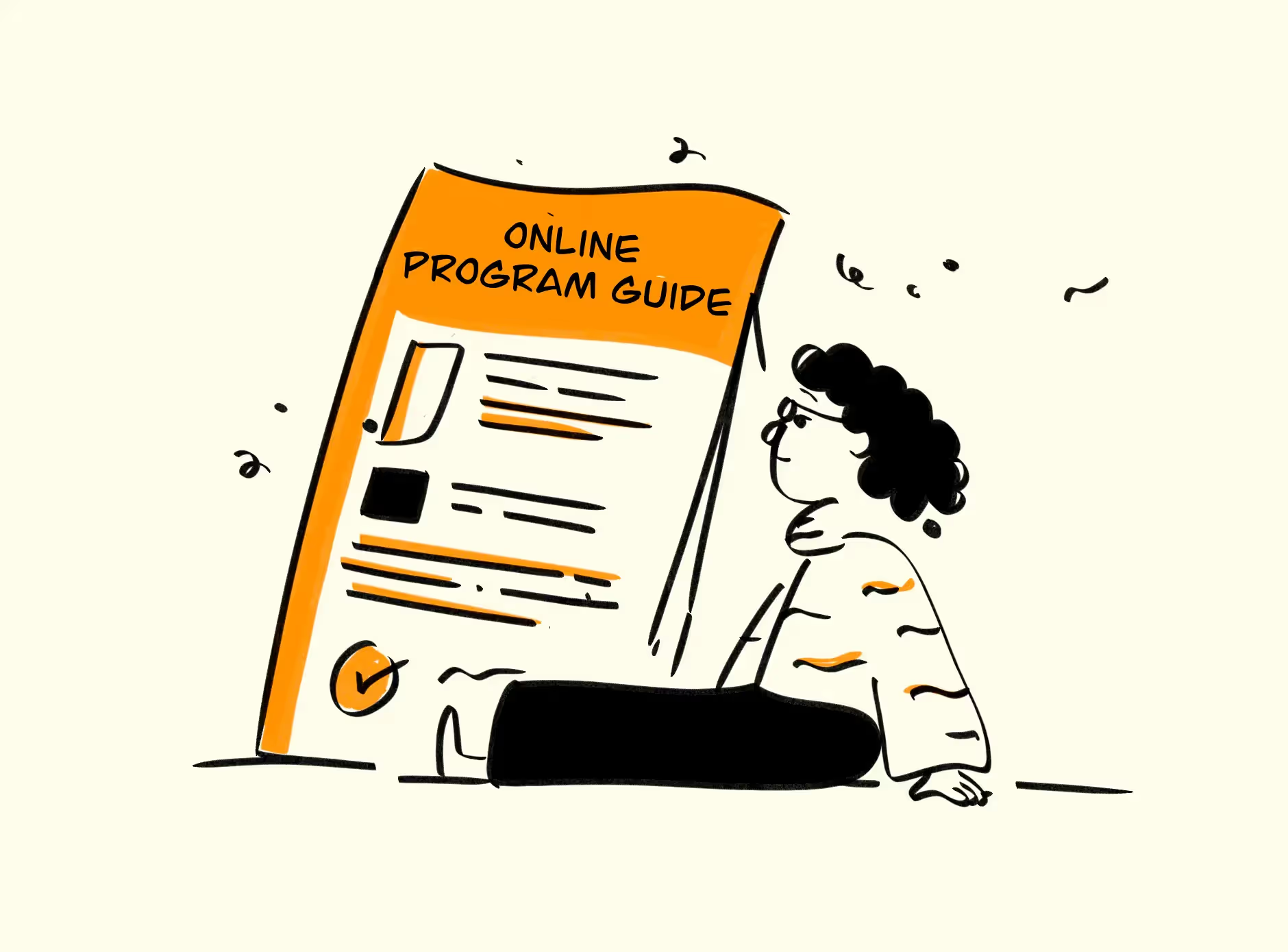


Key Takeaways
- Discover the Essential Factors for Choosing the Best Online Course Platform: Learn how to align your platform choice with your goals to enhance your course's success and profitability.
- Navigate the Pros and Cons of Self-Hosting vs. Marketplaces: Uncover the key differences to make an informed decision that best suits your online course strategy.
- Maximize Your Course Impact with the Right Platform: Find out how all-in-one platforms and LMS tools can boost student engagement, scalability, and overall course performance.
How To Choose The Best Online Course Platform To Host Your Course?
Online courses have become a cornerstone of education and professional development in today’s fast-paced digital world. The eLearning industry is booming, projected to surpass $300 billion by 2025. For educators, trainers, and businesses, choosing the right platform to host your online course is a crucial decision that can determine the success of your educational offering. With many options available, how do you select the best platform that aligns with your needs and goals? This guide will walk you through the types of online course platforms and the factors to consider when choosing. It will also answer common questions to help you decide about the best online course platforms.
Types of Online Course Platforms
When it comes to hosting online courses, there are several types of platforms to choose from. Each type has its own set of features, benefits, and drawbacks. Here’s a breakdown of the main types:
- Self-Hosted Platforms
- These platforms allow you full control over your course content, pricing, branding, and student data. Examples include WordPress with LMS plugins, or standalone solutions like Teachable and Thinkific.
- Course Marketplaces
- Marketplaces like Udemy and Coursera allow you to host your course on their platform in exchange for a share of the revenue. They handle marketing, payment processing, and provide access to a large student base, but you have less control over pricing and branding.
- All-in-One Platforms
- These platforms combine the features of self-hosted platforms and marketplaces, offering course creation tools, marketing, and sales support under one roof. Examples include Kajabi and Podia.
- Learning Management Systems (LMS)
- Ideal for institutions or businesses, LMS platforms like Moodle and Blackboard are designed to manage large-scale training programs with advanced features like tracking, reporting, and compliance.
Factors to Consider While Choosing the Best Online Course Platform
Choosing the right online course platform involves evaluating various factors that will affect your course’s reach, profitability, and overall success. Here are the key factors to consider:
- Ease of Use
- Look for a platform that is user-friendly, both for you as the course creator and for your students. A steep learning curve can deter you from creating content and can frustrate learners.
- Customization Options
- The ability to customize your course site’s look and feel, including branding, design, and layout, is crucial for creating a unique learning experience. Consider how much flexibility the platform offers in terms of design and functionality.
- Pricing and Monetization
- Evaluate the pricing structure of the platform, including subscription fees, transaction fees, and any hidden costs. Additionally, check how the platform supports different monetization strategies like one-time payments, subscriptions, or bundles.
- Marketing Tools
- A platform with integrated marketing tools such as email marketing, sales funnels, and affiliate programs can help you reach a wider audience and increase sales. Consider how well the platform supports your marketing efforts.
- Student Engagement Features
- Features like quizzes, certificates, forums, and interactive content can enhance the learning experience and keep students engaged. Look for platforms that offer robust student engagement tools.
- Integration Capabilities
- Ensure the platform can integrate with other tools you use, such as CRM systems, email marketing software, and analytics tools. This will help streamline your operations and provide a seamless experience for your students.
- Support and Community
- Consider the level of support offered by the platform, including customer service, training resources, and community forums. A strong support system can significantly improve your experience with the platform.
- Scalability
- If you plan to expand your course offerings or student base, choose a platform that can scale with you. Consider whether the platform can handle increasing numbers of students, courses, and content without compromising performance.
Self-hosting vs Marketplaces
Creating an online course is a fundamental part of being a successful online instructor, and understanding the course creation process is crucial. Creating an online course successfully, which you think is a masterpiece, call for a treat. Now, where do you treat yourself?
After creating an online course, you cannot keep it to yourself. Of course. But a real biggie comes when you need to establish a suitable platform to sell your course. There are predominantly two platforms to make your sales. One is self-hosting, the second is marketplaces. After creating their courses, creators often find it mind-boggling to choose what is best for them. Both the platforms have their share of pros and cons. Hopefully, this piece of the element will make your decisions wiser. Things are changing dramatically in the landscape of the e-learning industry. One needs to be on their toes and make themselves aware of the future uncertainties and how one would face them.
Book yourself for a couple of minutes to understand your online course requirements to make reasonable sales decisions. Let's start with the pros and cons of self-hosting. I would also suggest some of the popular platforms under respective categories.
Pros of self-hosting
There are numerous benefits of switching to self-hosting. As a community, it's important to ensure people know when this is a good idea. Not every site can switch over. Here are some advantages of self-hosting that should be considered.
- You own the email addresses of your students. Email marketing has tremendously become a significant part of transforming your business into a leading brand. One of the primary tasks while starting your online course is to reach out to the target audience. Well, in this case, you know who you are targeting, so send lots and lots of luring emails to officially get them on your platform.
Collecting email addresses from the targeted audience is a whole different procedure. But after receiving all of them, you do not want to risk losing them to someone else. Therefore, you own your students' email addresses to increase your course's profitability by either word of mouth or by collecting more emails from existing students. Can you read more about email marketing in my post, Build an Email List in 7 Easy Steps for Course Creators? - Charge as much as you want - When you are a self-host, you can charge as much as you desire for your online created course. You may charge based on value. Generally, people charge 15k for a course. That means you may charge $1000 for an hour's course or a lecture. Now, there seems to be an urge to immediately have it on your platter. You may also set payment modes according to your convenience. Give an option for the subscription of your own will. You can keep all the revenues generated to yourself except the credit card processing fee. That means you are going to save 100% of what you sell. Say no to intermediaries.
- Customize according to your will - When you are a self-host, you are your director. In that case, you have already decided on customizing your look for the course, from determining your logo to branding and packaging, collaborating with similar people working in the same domain, getting detailed information on competitor analysis, appointing your affiliates for marketing, creative heads to design the entire structure for sale and many more people to manage similar activities.
- Premium joint ventures with premium courses - Joint ventures to promote your course should witness that your course is premium enough to make a good turnover at the sales on your course. They will take you seriously only if they see promoting your course as a worthwhile investment of time and money on their websites.
Cons of self-hosting
Now that we've discussed the advantages of self-hosting, let's discuss a few of the cons. You should understand both sides before making your decision, right?
- Hosting fees - If you are a self-host, you will be charged a recurring monthly fee, plus you are being charged additional transaction fees. At an early stage of your business, the prices are minimal. Still, as you grow with thousands of students, you will spend more on email marketing automation tools, which can get more expensive occasionally.
- Market yourself - Self-hosting typically starts a mini start-up where you need to build marketing and sales pipelines, known as sales funnels. It is to attract and convert prospects into leads and leads into customers. You may also have to gather a suitable audience to buy your course. With absolute truth, marketing is the most critical yet tedious task in selling your course. But with the right strategies and persistence, you will surely hit the ground running.
- Lack of credibility - When you self-host, know that unless you are a representative of a leading brand, most people out there won't trust your product, and it becomes questionable after a point of time as to why they have to trust you or your online course. From marketplaces, there is filtering, and incapable online instructors are easy to spot because of their ratings and reviews.
Now, let's look into the pros and cons of the marketplace
Selling on marketplace sites is different from selling on your own site, particularly in how they can impact course sales. While there are both pros and cons to each, it really depends on your business needs. Each marketplace has its own form of metrics and can help you grow in unique ways. I’ll give you a breakdown of each below.
Pros of marketplace
Marketplaces are excellent tools for selling items and services. Here are some of the best benefits of using one for your business.
- Marketing is done right—By a long shot, the most significant advantage of facilitating your course in their marketplace is that the marketing they do for you will legitimately determine many of your deals. Since their income relies upon the number of students they bring to the stage, they are generally genuinely adept at showcasing and burning through many shillings in SEO improvement and are paid to promote each month.
- Enormous Student Base - A built-up online course marketplace has just done some work by pulling in several thousand, even if not many potential purchasers. Because of their course proposal motor, your course gets an opportunity to appear to many profoundly focused purchasers looking for your course theme in a particular marketplace.
- A well-supported student community—The marketplace has a personal stake in ensuring its educators are upbeat so they stay. To accomplish that objective, it provides a lot of free assistance and access to enormous educator online networks where everybody is encouraged to inspire and enable each other to succeed.
- Built-up Marketplaces Have Credibility - A few marketplaces have been around for a considerable time and have built up a reliable brand and validity. These are the critical components to assembling trust among potential purchasers who want to buy from a known brand rather than a moderately obscure free vendor.
The Cons Of Selling on Marketplaces
Selling on marketplaces can be a game-changer for some companies. It allows anyone to get an online store up and running with little time and effort. But bigger-scale sellers might be missing out on the control of creating their store. So, let's look into some cons of selling on marketplaces.
- No Access To Your Student Email Addresses - Your most significant resource as an online course maker is your students; however, your students don't have a place with you in the marketplace. They have a position in the markets. This makes it challenging to scale your business outside the market since you can't build a relationship with your students on your terms.
- Nothing is under your control - Consistently, you depend on the marketplace guidelines and predetermination. The marketplace chooses how frequently you can convey to your students, what you can advance or not when you message them, the amount you can charge for your courses, and to what extent you have held onto getting paid. If you don't keep their guidance, you can move out and lose access to every one of your students for the time being.
- Marketing isn't free. Fundamentally, the marketplace acts as a partner, and it can keep half or a greater amount of each deal it produces. Sometimes, if an agreement utilizes the above-listed organizations as one of its outsider offshoots, the educator gets the chance to keep 30% of every transaction.
- Your Brand Gets Mixed - The leading brand a marketplace is enthusiastic about advancing is its own, not yours. You might be permitted to watermark your recordings and wear a shirt with your organization's logo; however, that is how much you'll get to advance your image. You'll additionally not have the capacity to modify the vibe of your course pages; thus, consistently, your students will be presented with the marketplace logo and plan decisions. It could be said that when you are in a marketplace, you must remember that you are working for them and not the opposite way.
All-in-One Platforms vs Learning Management Systems (LMS)
When it comes to hosting and managing your online courses, an online course creation platform offers a versatile tool for educators and entrepreneurs, enabling users to create, manage, and monetize their courses effectively. You have a variety of platforms to choose from, each offering unique features and benefits. Two popular options are All-in-One Platforms and Learning Management Systems (LMS). While both platforms serve the same fundamental purpose of delivering online education, they cater to different needs and use cases. Understanding the differences between these platforms will help you decide which one is right for your course or training program.
Let’s dive into the details and weigh the pros and cons of each to help you decide.
All-in-One Platforms
All-in-one platforms are designed to be comprehensive solutions for online course creation. They provide creators with a streamlined process for building, marketing, and selling their courses. These platforms combine the best features of self-hosted solutions and marketplaces, offering everything they need under one roof.
Pros of All-in-One Platforms:
- Unified Experience: With an all-in-one platform, you have all the tools you need in one place, from course creation and hosting to marketing and sales. This unified experience can save you time and reduce the complexity of managing multiple tools.
- Ease of Use: These platforms are designed with user-friendliness, often featuring drag-and-drop builders and customizable templates. You don’t need extensive technical knowledge to get started.
- Marketing and Sales Tools: Integrated tools like email marketing, landing pages, and sales funnels make reaching your audience easier and converting leads into paying students.
- Community Building: Many all-in-one platforms allow you to create memberships, run subscriptions, and engage with your students through built-in community features.
- No Need for External Tools: Since everything is included, you won’t need to purchase or integrate third-party tools for email marketing, payment processing, or analytics.
Cons of All-in-One Platforms:
- Higher Costs: All-in-one platforms are more expensive than other options, which might concern new course creators or those with a tight budget.
- Limited Flexibility: While these platforms offer many features, they may not provide the level of customization that some advanced users or larger businesses require.
- Dependency on One Platform: You put all your eggs in one basket by relying on an all-in-one platform. If the platform experiences issues or doesn’t meet your evolving needs, you may find it challenging to migrate to another solution.
Learning Management Systems (LMS)
Learning Management Systems (LMS) and online course software are robust platforms designed to meet the needs of educational institutions, businesses, and organizations that require advanced features and scalability for their training programs. LMS platforms excel in providing detailed tracking, reporting, and compliance features.
Pros of LMS:
- Advanced Features: LMS platforms offer many features, including student tracking, reporting, assessments, and compliance management. These are essential for organizations that need to monitor progress and ensure learners meet specific learning outcomes.
- Scalability: LMS platforms are built to handle large-scale training programs with many users, making them ideal for universities, corporations, and government agencies.
- Customization: Many LMS platforms, especially open-source ones like Moodle, offer extensive customization options. You can tailor the platform to fit your organisation's or program's specific needs.
- Integration Capabilities: LMS platforms are designed to integrate with other enterprise systems, such as HR software, CRMs, and analytics tools. This makes it easier to manage learning as part of a broader organizational ecosystem.
Cons of LMS:
- Complexity: LMS platforms are often more complex and have a steeper learning curve than all-in-one platforms. They may require a dedicated IT team for setup, customization, and ongoing maintenance.
- Higher Initial Setup Costs: The initial cost of setting up an LMS can be high, especially if you require extensive customization or need to integrate it with other systems.
- Overkill for Small-Scale Courses: For individual course creators or small businesses, the advanced features of an LMS might be unnecessary and overwhelming. These platforms are often best suited for larger organizations with specific needs.
Which One Should You Choose?
The choice between an all-in-one platform and an LMS ultimately depends on your needs and goals.
- All-in-one platforms are ideal for individual course creators, small businesses, or those who want a simplified, all-encompassing solution for building, marketing, and selling online courses. If you’re looking for ease of use and don’t require advanced features, an all-in-one platform could be your best choice.
- Learning Management Systems (LMS) are better suited for larger organizations, educational institutions, or businesses that require advanced features, detailed reporting, and scalability. An LMS might be the right fit if you need a platform that can grow with your organization and integrate with other systems.
In conclusion, both types of platforms have strengths and weaknesses, and the right choice depends on your specific needs. When deciding, consider your long-term goals, budget, and the complexity of your course or training program.
But tools like EdisonOS give you the striking balance of an all-in-one platform and a robust Learning management system. With EdisonOS, you can easily build your online course without paying the high costs usually associated with robust tools like EdisonOS.
How do you get your First Students?
After creating your course on online learning platforms, the first thing you think of is selling your course. You need to follow the sub-elements coming up your way. A significant aspect you should focus on is marketing and doing marketing. There is an acronym that defines marketing in the best possible way:
A-I-D-A: ATTENTION, INTEREST, DESIRE, ACTION
Marketing is all about grabbing the attention of your target audience. People are going to be interested to see what you have to offer them, it is going to build desire within them, and then the final call will be to take action and buy your product. Being literal enough on what it takes to do marketing, let us move on to one powerful way of getting your students. It strains your energy, but if you have reached the tactic and suitable machine to handle, you win the jackpot for life.
What is a Funnel system?
With hardships comes ease. All top instructors use this precise marketing technique called the "webinar funnel".
A funnel is a set of strategies that builds trust over a series of steps, making people more likely to buy. If you intend to multiply what you gain from 10 to 100, then get serious about building a funnel. Let's examine the process of funnel building.
Driving Paid Traffic
Paid traffic is when any customer visits your website once paid for advertising promotions. Platforms like search engines, media networks and social media sites are the most commonly used platforms for paid advertisements. The other popular platforms you can rely on are YouTube, Google AdWords and Facebook. These two social networking platforms generate the most traffic.
In one of my previous blogs, you can read more about the 8 Ways to Get Views and Reach People on YouTube. The objective of paid traffic is to acquire customers to keep your business growing substantially. The more you are willing to spend to reach your customers to avoid drying up your business, the better chances you have of managing your business, at least at the break-even point.
Tips on Paid Traffic
Remember, establishing paid traffic aims to build a healthy relationship through the inception of your business. Hence, target your ideal customer. Selling your course requires understanding the critical points of your audience. Every coin has two sides. As much as paid traffic has, if you are trying to benefit from it, you may have drawbacks.
The Advantage of Paid Traffic
If used well, you can obtain much more from paid traffic. One of the significant benefits is deciding on your expenditure to get direct paid traffic. You know how much you have invested in creating your course to spend on promotion. Decide on the maximum amount you would want to spend for the day on certain types of advertising like 'pay per click'. You may also opt for a keyword search engine to drive targeted traffic cautiously.
The Disadvantage of Paid Traffic
It's unnecessary for someone visiting your website to buy your product. It isn't obligatory to do so. Poor design or not-so-organic content might trigger a consumer to leave the website immediately. If it did, chances are the bounce rate would increase rapidly, leading to lower Google ranking still being charged for every visit.
Landing Page
Getting visitors is insufficient; you need to convert the visitors into leads. The very purpose of landing pages is to convert visitors into leads. To do that right, you need to know some facts about landing pages and how they work. When a visitor clicks on your website, there is a form that captures its necessary information such as email IDs, your name, and your preferences—giving a straightforward way for your prospective visitors to buy your product.
How do Landing Pages work?
In simple terms, there are four steps to creating a visitor into leads. Once a person sees a call to action, they visit your website and end up on a landing page with a form. When a person fills out that form simply knowing the buyer's persona, the visitor turns into a lead. The leads database you have determined is then segregated with what visitors have opted in the form. You then market your product or a tip based on their preferences or what you know about them.
Through landing pages, you can also dispense a few freebies, such as a brief overview of your course in the form of a PDF, report, ebook, or mini-course and in exchange for the freebies, they are going to give you their email addresses. You may then resume a considerable amount of follow-ups. Soon after bestowing some freebies, you can direct them to a webinar where you give any information or valuable tips on your product. A webinar is like a live presentation, pitching your sales at the end. Once it is at the edge of consumer satisfaction, sell it your course.
Free Traffic
This is another way of driving targeted traffic to your website; it takes a little extra time from what it does in paid traffic. Nothing unusual, though. If you are not in a hurry to market your product or are off-budget and would want to take it slow and steady, then go for a free traffic scheme.
Free traffic is purely your blog; you get searched and found through social networking sites and YouTube. Your visitors will fill in an opt-in form where you collect their email addresses. Now, your email list is the holy grail of your online business. You can look for MailChimp, AWeber, convert kit and active campaign to collect the email IDs. Once you have sufficient email addresses, start warming them up to a valuable sequence to follow up with different content in each mail. The maximum number of trials you can give is 3-4 times. Other relevant content could mean a video, a PDF file, a short post, etc. Ultimately, please direct them to a free webinar and sell your product. Therefore, this is one side of the funnel through free traffic.
Conclusion
People will always throw around terms like “hot” and “trendy” when talking about online courses, but the truth is that these courses are still fairly new. More importantly, who knows what tomorrow has in store for the industry? For example, it's likely that in 2022, there will likely be many choices among course platforms. Currently, most platforms focus on one thing (open enrollment, monetizing videos, focusing on instructors), and that's why you see so many big names trying to dominate different aspects of the market. My point is: don't get too caught up in the hype. Focus on finding an online course platform that fits your needs today, and figure out how you want your company to develop in the future.
This has a million variations, but the above-listed ways are the most effective. So dive in, experiment with different options, and have fun!
FAQs
- Which platform is best for online courses?
- The best platform depends on your specific needs. If you want complete control, a self-hosted platform might be best. For those who want easy access to a large student base, a marketplace like Udemy could be ideal. But if you are planning to build your brand, then a platform like EdisonOS makes a lot of sense for you as it gives you all the features and benefits at a fraction of the cost of developing the infrastructure on your own.
- Which hosting is best for online courses?
- The best hosting option depends on your technical skills and budget. Self-hosting offers the most control but requires more effort, while managed hosting services provide ease of use at a higher cost.
- How do I start an online learning platform?
- To start an online learning platform, choose the right platform, create high-quality content, and market your course effectively. Consider your target audience, pricing strategy, and the tools you need to manage and grow your course.
- What is a course hosting platform?
- A course hosting platform is a service that allows you to create, publish, and sell online courses. It provides the necessary tools for course creation, student management, and payment processing.
- How to create a course and sell it online?
- Start by choosing a platform that suits your needs. Then, create high-quality content, set up your course structure, and market it using the platform's tools or marketing strategies.
- How to launch an online course?
- Launching an online course involves preparing your content, setting up your course on the chosen platform, and executing a marketing plan to attract students. To drive traffic to your course, utilize email marketing, social media, and SEO.
Tutors Edge by EdisonOS
in our newsletter, curated to help tutors stay ahead!
Tutors Edge by EdisonOS
Get Exclusive test insights and updates in our newsletter, curated to help tutors stay ahead!
Recommended Reads
Recommended Podcasts












.png)
.webp)
